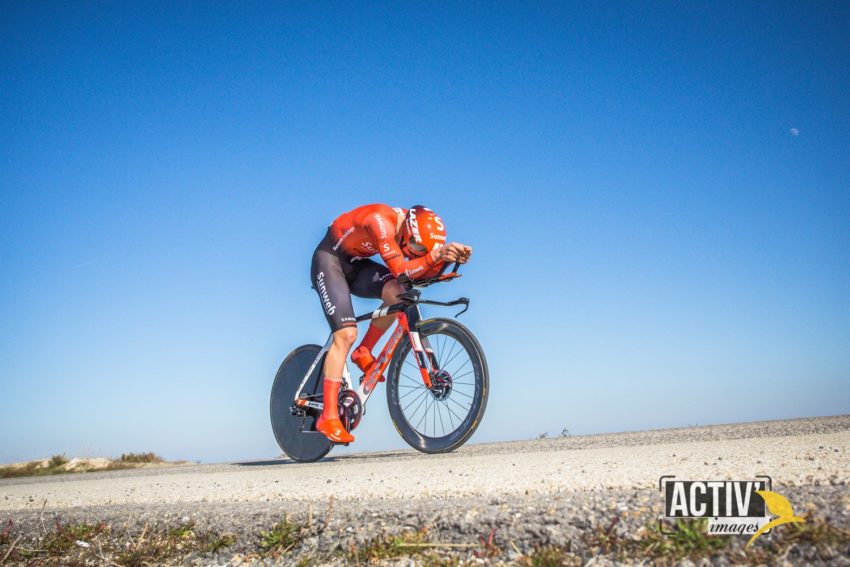We often hear about FTP, these three letters that stand for Functional Threshold Power. But what does it actually mean? How can you perform an FTP test? How can you use this data to optimize your training? In this article, we explain the concept of FTP in exercise physiology, detailing how to perform an FTP test in the three triathlon disciplines and providing tips to maximize its benefits.
Article published in TrimaX-magazine n°201– November 2020 Author: Simon Billeau
This article was provided to us by Trimax Magazine, one of the leading triathlon magazines. A new edition is published every month, featuring articles, profiles, race tips, equipment advice, and much more. To discover all the latest news in triathlon, cycling, running, duathlon, and swimrun for free, click here.
FTP: Definition and Use
FTP is the maximum pedaling power a cyclist can sustain for one hour, according to Coggan and Hunter. Typically, athletes primarily use it in cycling, but it can also be used in running and swimming. We will describe the tests adapted for these two disciplines later.
Historically, FTP is a relatively young concept. Andrew Coggan and Hunter Allen brought this scientific notion to light in 2006 in their book “Training and Racing with a Power Meter”. However, if we try to be objective, the FTP concept is neither revolutionary nor new. First, let us offer you a brief historical overview of exercise physiology, as the relationship between FTP and anaerobic threshold (MLSS, or LT, or SL2 depending on the different researchers’ abbreviations) is very close.
Studies, Speed-Time Relationship, and Performance Curve: The Origins
In 1906, the first article on a prospective study of running records was published. Its author, Kennelly (an electrical engineer at Harvard), was the first to address the form of the relationship that links speed as a function of time (performance curve). Later, physiologist and Nobel Prize winner Archibald Vivian Hill (1927), who was a pioneer in the bioenergetics of muscle exercise, contributed to this approach. We owe him the introduction of numerous concepts (maximal oxygen consumption, oxygen debt) that he used to explain the form of the speed-time relationship in running, elaborated from world records ranging from the 100 m to the marathon.
It is then possible to consider exercise durations for which the speed loss is minimal. For example, when doubling the running duration from 10 to 20 seconds, the speed is maintained at 36 km/h, and when going from 1 hour to 2 hours, only 1 km/h is lost. Conversely, in some portions of the curve linking speed to running time, there are breaks showing significant speed losses for relatively close times, such as from the first to the second minute of running, where speed drops from 33 to 28 km/h.
The study of this curve allowed early-century physiologists to hypothesize and detect similarities regarding limiting factors and the energy qualities required for these different speed-duration pairs, which determine performance: time spent over a given distance fixed by the sports federation regulations. It is remarkable to note that this relationship between speed and maintenance duration has not changed over the century when comparing the slopes of the curves. This means that the evolution of world records over short and long distances has occurred equally throughout the century, and one can run longer at 36 km/h but also at 20 km/h.

Anaerobic Threshold and VO2 Max
What are the energy parameters that affect a runner’s performance?
To predict a runner’s performance over long distances, two main factors must be considered:
- Metabolic power: this is the runner’s ability to convert stored chemical energy (from carbohydrates, fats, proteins, and creatine phosphate) into mechanical energy to power the muscles. For exercises lasting more than 3 minutes, this transformation occurs through oxygen. For example, one liter of oxygen consumed generates 21 kJ of energy.
- Energy cost: this is the amount of energy required to run at a certain speed. Pietro di Prampero created an equation that shows the relationship between metabolic power (Er), running speed (V), and energy cost (Cr):
Er = Cr x V
Every person has a maximum oxygen consumption (VO2 Max), which can be 10 to 25 times higher than the resting metabolism. For example, an elite athlete can have a very high VO2 Max (up to 88 ml/min/kg, as measured in top-level cyclists like Indurain or Bernal).
Performance differences: power and endurance
Billat et al. (1994) showed that the time an athlete can maintain their VO2 Max can vary by 25% between athletes of the same level, even though their oxygen consumption only varies by 5%. This means that not only power (VO2 Max) is important, but also endurance. Endurance is measured by a parameter called factor F, which indicates how long an athlete can sustain a certain fraction of their VO2 Max.
When glycolysis becomes too fast, the body can no longer convert NADH (a compound involved in energy production) into NAD. This leads to an increase in lactate production, which lowers muscle and blood pH and causes fatigue.
Lactate threshold and FTP
The speed at which the body starts to accumulate lactate is called the lactate threshold (or “anaerobic threshold”). It occurs between 60% and 90% of VO2 Max. If a runner can run faster before reaching this threshold, it means they have trained to use fewer fast-twitch muscle fibers and increased the oxidative capacity of their muscles.
On average, a runner can complete a marathon at a speed corresponding to 90-95% of their lactate threshold, or about 80-85% of their VO2 Max.
How to measure the anaerobic threshold
The anaerobic threshold is often measured in the lab by taking a drop of blood to check lactate levels during constant-speed efforts. However, since this is not practical for most athletes, the concept of FTP (Functional Threshold Power) was introduced in the early 21st century as a simpler way to estimate the anaerobic threshold.
Maximum oxygen consumption can only be sustained for a limited period (from 4 to 10 minutes) due to lactate buildup. This lactate increase quickly leads to muscle fatigue, making it impossible to continue exercising at the same intensity. FTP is based on a one-hour test, which approximates the limit time at which an athlete can sustain effort at their anaerobic threshold.

FTP Test in Cycling
If you want to perform your FTP test in cycling, you need a bike with a power meter. You also need a bike computer to record the data. Additionally, it is beneficial to use a heart rate monitor to correlate heart rate with power. Lastly, a cadence sensor is useful since pedaling frequency affects glycogen usage at a given power.
To perform the test, you can do it on the road. In that case, choose a relatively flat area without intersections and, for your safety, with minimal traffic. With the arrival of winter and for reproducibility reasons, we recommend using a home trainer. This allows you to focus on the test.
Some of these home trainers have an integrated power meter. Without delving into the debate about power meter reliability, what matters is using the same protocol with the same equipment. This will allow you to compare your FTP in the future and see any progress. If you are subscribed to Zwift or The Sufferfest, there is an FTP test protocol, and the different zones are automatically calculated for you. If you do it manually, here are the different training zones based on your FTP percentages:
The FTP value allows for the establishment of 7 power zones, also known as “Coggan zones”:
- Zone 1: Active recovery (< 55% FTP)
- Zone 2: Endurance (56 to 75% FTP)
- Zone 3: Tempo (76 to 90% FTP)
- Zone 4: Lactate threshold (91 to 105% FTP)
- Zone 5: VO2max (106 to 120% FTP)
- Zone 6: Anaerobic capacity (121 to 150% FTP)
- Zone 7: Neuromuscular power (> 150% FTP)
These zones allow for specific training based on power type and help monitor effort during sports events.

FTP Test in Swimming
As mentioned earlier, it is possible to perform an FTP test in swimming. To do this, head to the pool during a relatively quiet time. A 1000 m swim as fast as possible is ideal. Then, simply divide the total time by 10 to get what researchers call the T-Time or threshold time. In short, this is your zone 4.
FTP Test in Running
For running, a test on a flat 10-15 km course is suitable. Choose 10 km if you run 10 km in 45 minutes or more, or run 15 km if you are faster.
Try to use the same shoes and clothing, once again for comparison reasons. A heart rate monitor is useful if you want to correlate your heart rate with your speed. Recently, power meters have also been introduced in running (Stryd). It is important to perform an FTP test approximately every 4-6 weeks to recalibrate your FTP value.
Now that your intensity zones are defined, all that’s left is to train intelligently to push these values higher. Also, keep in mind that your performance will improve if you train at your race-specific speed. Understand that if you train at 15 km/h in running while your best marathon time is 3h15, it is very likely that you will fail in your personal record attempt, as physiological adaptations are correlated to the training zones utilized.


